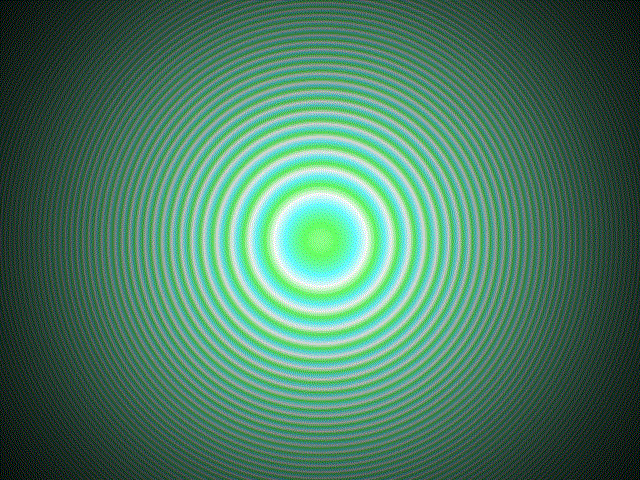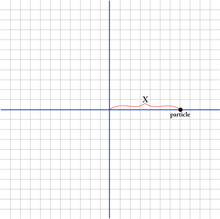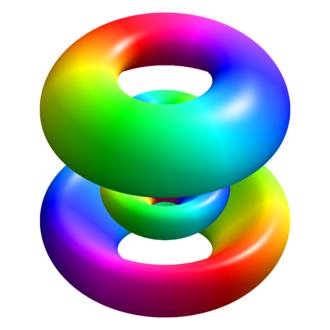The Curious Quantum World: Part 4 - Infinite Exactness

In Newtonian physics, both the position and velocity of a particle can be specified to an infinite level of precision.
Not so in quantum mechanics, where these are limited by Heisenberg’s uncertainty principle. A quantum particle simply does not have both a definite position and a definite momentum. In the same way, no process can occur at a definite time with a definite energy. This indeterminacy principle has many important consequences.

(Image of the evolution of gaussian wave function, a free particle in two-dimensional space, the color and intensity indicate its phase and amplitude.)
How is it that we can learn exactly where a quantum particle is, or where it is going, but not both at the same time?

Recall Laplace’s demon, an imaginary being who knows the present position and velocity of every particle in the universe. By applying Newton’s laws of motion, the demon should be able to perfectly predict the future. However, even a fairly simple system may be impossible to predict, because chaos makes even a deterministic system unpredictable. The same is true on the particle level, not because of chaos, but because of uncertainty, a fundamental aspect of quantum mechanics.
The uncertainty principle was discovered by Werner Heisenberg soon after quantum mechanics was invented.

- Imagine a particle moving along a line motion in one dimension and call its position on the line
x. - The particle moves with a certain velocity
v. - Its momentum, p, is determined by its mass times its velocity:
mv = p.
In Newtonian physics, the particle always has a definite position in space and a definite momentum.
However, a quantum particle is described by probabilities; rather than definite values for x and p, there is a range.

We express this as ∆x, uncertainty in position, and ∆p, uncertainty in momentum. Their product is always greater than Planck’s constant: ∆x∆p > h. The more precisely we know x, the less precisely we can know p, and vice versa.
Planck’s constant, which determines the size of quantum effects, is extremely tiny:
6.63 × 10−34 kilograms per square meter per second

For an ordinary object say, a thrown baseball we could know its position and momentum to 15 or 16 decimal places. For minuscule particles like atoms, photons, and electrons, the numbers are so small that we can never hope for real accuracy. Then Heisenberg's Uncertainty Principle comes in....
End Part 4
PART 1, PART 2, PART 3, PART 4
Image Credits (in order):
https://i.ytimg.com/vi/ZpwZgOumTrs/maxresdefault.jpghttps://upload.wikimedia.org/wikipedia/commons/4/47/Uncertainty_principle.gifhttp://www.coasttocoastam.com/cimages/var/ezwebin_site/storage/images/coast-to-coast/repository/photos/pickover-images-laplace-s-demon/619858-1-eng-US/Pickover-Images-Laplace-s-Demon.jpghttps://upload.wikimedia.org/wikibooks/en/thumb/4/48/Particle.png/220px-Particle.pnghttps://upload.wikimedia.org/wikipedia/commons/thumb/6/65/Hydrogen_eigenstate_n5_l2_m1.png/330px-Hydrogen_eigenstate_n5_l2_m1.pnghttp://mental-ephemera.com/wp-content/uploads/2012/03/atom_baseball.jpg
Just a note to add, in my opinion: the momentum of a particle is not always equal to the product of the particle mass and its velocity. This is actually only true in the absence of any external field (otherwise its expression gets slightly more complicated).
https://steemit.com/physics/@l0k1/the-geometry-of-gravity-and-the-geometry-of-linear-acceleration
I say that the reason why this exists is because gravity is a macro phenomenon, and below a certain mass, its effects are negligable, and the power of orbiting electrons to dictate the mechanical and geometric arrangement of atoms dominates.
Newton is still correct, but gravity is a product of electron activity, and therefore not a factor in what regulates it. Electrons regulate the associativity, along with photons, of nuclear (inert) particles, such as neutrons, neutrinos, and the cluster we call an atomic nucleus. My hypothesis is that the very effect of gravity is caused by electrons, in massive, nearly perfect disorder, float around all matter. They do this, because electrons oppose the expansion of space, which would otherwise drive the inert matter particles apart.
So, even when it appears you have a static system, like a blob of metal, we also know that the electrons are in constant flux between atoms, and metallic atoms have the property of near perfect associativity with electrons. That is, you have to disrupt them with a LOT of photons in order to make them change states (infrared).
I think that the mathematics only seems complicated, because it is hard to make a picture to show someone. When you can show a picture, the simplicity can be grasped, even if it took half a chalkboard to write the mathematical algorithm.
This is intriguing. I have however one naive question: how can you explain the absence of visible effects of your theory within all particle physics data so far?
Moreover, I do not see how gravity could be related to electrons. Their mass is so tiny that the associated gravity strength is suppressed by more than 30 orders of magnitude compared to the strength of electromagnetism or of the weak interactions.
Finally, the structure of the atomic nucleus is quite well known today. And it does match your claims above.
Yes, the thing is that when electrons are in balance, they cannot be detected. It is the central premise of Zero Point energy theories, the old Aether theory. I get that it may seem outlandish. However, as you point out, I have not deviated from the data. My hypothesis aims to explain and connect things that so far physicists have not connected, and it bridges quantum and relativistic and newtonian physics, and provides a much simpler and more logical explanation for what String Theory and Dark Energy/Dark matter are attempts to explain.
The question of how electrons can produce a gravitational effect is based on my idea that these largely paired electrons (and note, that they do occasionally register on measuring devices) that are largely aligned towards the centres of mass of bodies of matter, and operate on the macro scale the same way as electrons, in their dance around with photons and neutral inert particles like Protons and Neutrons, in fact 'knit' matter together.
Despite the much larger distances involved in this model of gravity, the principle is that electrons, wherever they are, are attracted to the inert particle, specifically, the proton. Even if they cannot get into a close relationship with atoms, binding their structure, they bind the structure of large bodies of matter, through a geometry of radial anisotropy and mass (really, a very understatement) effects.
It is precisely because of the relative incoherence of this Electron Fog, as I labelled it, that it has such a relatively weak effect on moving matter around. Nevertheless, it is the same principle as I alluded to. My first premise is that space is expanding, and consists of incompressible, massless primary particles, which overlay and interact with higher order patterns that emerge out of the iterative process of each 'moment' of time, so to speak (my model of time perhaps draws from cybernetic-information physics models, I assert there is a fundamental discrete nature of the fundamental fabric of space). These primary particles are endlessly dividing, and their number expands at the rate we experience as light speed.
You can read more of my answers to questions about the mathematics involved on the thread I linked above.
Thank you for continuing to follow my posts @lemouth and as always you are 100% correct. To allow a broader audience to comprehend the content in this series it intentionally avoids any overly complex mathematics.
Strictly speaking, many concepts presented in physics in non-mathematical terms are simplifications or metaphors because abstractions and approximations are required to translate math into words and images.